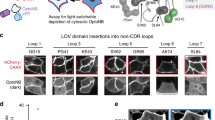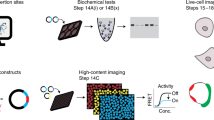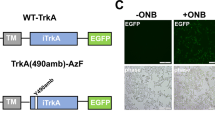Abstract
The rapid and selective regulation of a target protein within living cells that contain closely related family members is an outstanding challenge. Here we introduce genetically directed bioorthogonal ligand tethering (BOLT) and demonstrate selective inhibition (iBOLT) of protein function. In iBOLT, inhibitor–conjugate/target protein pairs are created where the target protein contains a genetically encoded unnatural amino acid with bioorthogonal reactivity and the inhibitor conjugate contains a complementary bioorthogonal group. iBOLT enables the first rapid and specific inhibition of MEK isozymes, and introducing photoisomerizable linkers in the inhibitor conjugate enables reversible, optical regulation of protein activity (photo-BOLT) in live mammalian cells. We demonstrate that a pan kinase inhibitor conjugate allows selective and rapid inhibition of the lymphocyte specific kinase, indicating the modularity and scalability of BOLT. We anticipate that BOLT will enable the rapid and selective regulation of diverse proteins for which no selective small-molecule ligands exist.
This is a preview of subscription content, access via your institution
Access options
Subscribe to this journal
Receive 12 print issues and online access
$259.00 per year
only $21.58 per issue
Buy this article
- Purchase on Springer Link
- Instant access to full article PDF
Prices may be subject to local taxes which are calculated during checkout







Similar content being viewed by others
References
Shogren-Knaak, M. A., Alaimo, P. J. & Shokat, K. M. Recent advantages in chemical approaches to the study of biological systems. Annu. Rev. Cell Dev. Biol. 17, 405–433 (2001).
Knight, Z. A. & Shokat, K. M. Chemical genetics: where genetics and pharmacology meet. Cell 128, 425–430 (2007).
Schreiber, S. L. Organic synthesis toward small-molecule probes and drugs. Proc. Natl Acad. Sci. USA 108, 6699–6702 (2011).
Belshaw, P. J., Schoepfer, J. G., Liu, K-Q., Morrison, K. L. & Schreiber, S. L. Rational design of orthogonal receptor–ligand combinations. Angew. Chem. Int. Ed. 34, 2129–2132 (1995).
Bishop, A. C. et al. A chemical switch for inhibitor-sensitive alleles of any protein kinase. Nature 407, 395–401 (2000).
Zheng, H., Al-Ayoubi, A. & Eblen, S. T. MAP Kinase Signaling Protocols Vol. 661 (Springer, 2010).
Erlanson, D. A., Wells, J. A. & Braisted, A. C. Tethering: fragment-based drug discovery. Annu. Rev. Biophys. Biomol. Struct. 33, 199–223 (2004).
Cravatt, B. F., Wright, A. T. & Kozarich, J. W. Activity-based protein profiling: from enzyme chemistry to proteomic chemistry. Annu. Rev. Biochem. 77, 383–414 (2008).
Takaoka, Y., Ojida, A. & Hamachi, I. Protein organic chemistry and applications for labeling and engineering in live-cell systems. Angew. Chem. Int. Ed. 52, 4088–4106 (2013).
Chen, Z., Jing, C., Gallagher, S. S., Sheetz, M. P. & Cornish, V. W. Second-generation covalent TMP-Tag for live cell imaging. J. Am. Chem. Soc. 134, 13692–13699 (2012).
Liu, Q. et al. Developing irreversible inhibitors of the protein kinase cysteinome. Chem. Biol. 20, 146–159 (2013).
Blair, J. A. et al. Structure-guided development of affinity probes for tyrosine kinases using chemical genetics. Nature Chem. Biol. 3, 229–238 (2007).
Volgraf, M. et al. Allosteric control of an ionotropic glutamate receptor with an optical switch. Nature Chem. Biol. 2, 47–52 (2006).
Fehrentz, T., Schönberger, M. & Trauner, D. Optochemical genetics. Angew. Chem. Int. Ed. 50, 12156–12182 (2011).
Szymański, W., Beierle, J. M., Kistemaker, H. A. V., Velema, W. A. & Feringa, B. L. Reversible photocontrol of biological systems by the incorporation of molecular photoswitches. Chem. Rev. 113, 6114–6178 (2013).
Sletten, E. M. & Bertozzi, C. R. Bioorthogonal chemistry: fishing for selectivity in a sea of functionality. Angew. Chem. Int. Ed. 48, 6974–6998 (2009).
Lang, K. & Chin, J. W. Bioorthogonal reactions for labeling proteins. ACS Chem. Biol. 9, 16–20 (2014).
Lang, K. & Chin, J. W. Cellular incorporation of unnatural amino acids and bioorthogonal labeling of proteins. Chem. Rev. 114, 4764–4806 (2014).
Lang, K. et al. Genetically encoded norbornene directs site-specific cellular protein labelling via a rapid bioorthogonal reaction. Nature Chem. 4, 298–304 (2012).
Plass, T. et al. Amino acids for Diels–Alder reactions in living cells. Angew. Chem. Int. Ed. 51, 4166–4170 (2012).
Kaya, E. et al. A genetically encoded norbornene amino acid for the mild and selective modification of proteins in a copper free click reaction. Angew. Chem. Int. Ed. 51, 4466–4469 (2012).
Seitchik, J. L. et al. Genetically encoded tetrazine amino acid directs rapid site-specific in vivo bioorthogonal ligation with trans-cyclooctenes. J. Am. Chem. Soc. 134, 2898–2901 (2012).
Lang, K. et al. Genetic encoding of bicyclononynes and trans-cyclooctenes for site-specific protein labeling in vitro and in live mammalian cells via rapid fluorogenic Diels–Alder reactions. J. Am. Chem. Soc. 134, 10317–10320 (2012).
Elliott, T. S. et al. Proteome labeling and protein identification in specific tissues and at specific developmental stages in an animal. Nature Biotechnol. 32, 465–472 (2014).
Bianco, A., Townsley, F. M., Greiss, S., Lang, K. & Chin, J. W. Expanding the genetic code of Drosophila melanogaster. Nature Chem. Biol. 8, 748–750 (2012).
Krishnamurthy, V. M. et al. Carbonic anhydrase as a model for biophysical and physical–organic studies of proteins and protein–ligand binding. Chem. Rev. 108, 946–1051 (2008).
Vauquelin, G. Simplified models for heterobivalent ligand binding: when are they applicable and which are the factors that affect their target residence time. Naunyn-Schmiedeberg’s Arch. Pharmacol. 386, 949–962 (2013).
Gargano, J. M., Ngo, T., Kim, J. Y., Acheson, D. W. K. & Lees, W. J. Multivalent inhibition of AB5 toxins. J. Am. Chem. Soc. 123, 12909–12910 (2001).
Krishnamurthy, V. M., Semetey, V., Bracher, P. J., Shen, N. & Whitesides, G. M. Dependence of effective molarity on linker length for an intramolecular protein–ligand system. J. Am. Chem. Soc. 129, 1312–1320 (2007).
Hilger, R. A., Scheulen, M. E. & Strumberg, D. The Ras-Raf-MEK-ERK pathway in the treatment of cancer. Oncol. Res. Treat. 25, 511–518 (2002).
Sebolt-Leopold, J. S. & Herrera, R. Targeting the mitogen-activated protein kinase cascade to treat cancer. Nature Rev. Cancer 4, 937–947 (2004).
Solit, D. B. et al. BRAF mutation predicts sensitivity to MEK inhibition. Nature 439, 358–362 (2006).
Brott, B. K. et al. Mek2 is a kinase related to Mek1 and Ts differentially expressed in murine tissues. Cell Growth Differ. 4, 921–929 (1993).
Giroux, S. et al. Embryonic death of Mek1-deficient mice reveals a role for this kinase in angiogenesis in the labyrinthine region of the placenta. Curr. Biol. 9, 369–376 (1999).
Ussar, S. & Voss, T. MEK1 and MEK2, different regulators of the G1/S transition. J. Biol. Chem. 279, 43861–43869 (2004).
Zhao, Y. & Adjei, A. A. The clinical development of MEK inhibitors. Nature Rev. Clin. Oncol. 11, 385–400 (2014).
Tecle, H. et al. Beyond the MEK-pocket: can current MEK kinase inhibitors be utilized to synthesize novel type III NCKIs? Does the MEK-pocket exist in kinases other than MEK? Bioorg. Med. Chem. Lett. 19, 226–229 (2009).
Rice, K. D. et al. Novel carboxamide-based allosteric MEK inhibitors: discovery and optimization efforts toward XL518 (GDC-0973). ACS Med. Chem. Lett. 3, 416–421 (2012).
Yao, J. Z. et al. Fluorophore targeting to cellular proteins via enzyme-mediated azide ligation and strain-promoted cycloaddition. J. Am. Chem. Soc. 134, 3720–3728 (2012).
Barrett, S. D., Biwersi, C., Kaufman, M., Tecle, H. & Warmus, J. S. Oxygenated esters of 4-iodo phenylamino benzhydroxamic acid. International patent WO 02/06213 (2002).
Hamon, F., Djedaini-Pilard, F., Barbot, F. & Len, C. Azobenzenes—synthesis and carbohydrate applications. Tetrahedron 65, 10105–10123 (2009).
Renner, C. & Moroder, L. Azobenzene as conformational switch in model peptides. ChemBioChem 7, 868–878 (2006).
Beharry, A. A., Wong, L., Tropepe, V. & Woolley, G. A. Fluorescence imaging of azobenzene photoswitching in vivo. Angew. Chem. Int. Ed. 50, 1325–1327 (2011).
Tang, P. C. et al. Pyrrole substituted 2-indolinone protein kinase inhibitors. US patent 6,573,293 (2003).
Gajiwala, K. S. et al. KIT kinase mutants show unique mechanisms of drug resistance to imatinib and sunitinib in gastrointestinal stromal tumor patients. Proc. Natl Acad. Sci. USA 106, 1542–1547 (2009).
Palacios, E. H. & Weiss, A. Function of the Src-family kinases, Lck and Fyn, in T-cell development and activation. Oncogene 23, 7990–8000 (2004).
James, J. R. & Vale, R. D. Biophysical mechanism of T-cell receptor triggering in a reconstituted system. Nature 487, 64–69 (2012).
Au-Yeung, B. B. et al. The structure, regulation, and function of ZAP-70. Immunol. Rev. 228, 41–57 (2009).
Schmied, W. H., Elsässer, S. J., Uttamapinant, C. & Chin, J. W. Efficient multisite unnatural amino acid incorporation in mammalian cells via optimized pyrrolysyl tRNA synthetase/tRNA expression and engineered eRF1. J. Am. Chem. Soc. 136, 15577–15583 (2014).
Sander, J. D. & Joung, J. K. CRISPR-Cas systems for editing, regulating and targeting genomes. Nature Biotechnol. 32, 347–355 (2014).
Mansour, S. et al. Transformation of mammalian cells by constitutively active MAP kinase kinase. Science 265, 966–970 (1994).
Acknowledgements
This work was supported by the UK Medical Research Council (grants nos. U105181009 and UD99999908) and the European Research Council. Y-H.T. was supported by an EMBO Long-Term Fellowship and S.E. by a DFG Research Fellowship. J.R.J. is a Sir Henry Dale fellow of The Wellcome Trust and The Royal Society. The authors thank K. Wang, L. Davis and M. Mohan for discussions, S. Elsaesser for plasmids and T. Elliot for compound 16.
Author information
Authors and Affiliations
Contributions
J.W.C. conceived the project. Y-H.T., S.E. and J.R.J. conceived, designed and performed the experiments. S.E. designed and performed the photo-BOLT experiments. K.L. contributed materials. Y-H.T., S.E., J.W.C. and J.R.J. analysed the data. Y-H.T., S.E. and J.W.C. wrote the paper.
Corresponding author
Ethics declarations
Competing interests
The authors declare no competing financial interests.
Supplementary information
Supplementary information
Supplementary information (PDF 5529 kb)
Supplementary movie
Supplementary movie 1 (MP4 475 kb)
Rights and permissions
About this article
Cite this article
Tsai, YH., Essig, S., James, J. et al. Selective, rapid and optically switchable regulation of protein function in live mammalian cells. Nature Chem 7, 554–561 (2015). https://doi.org/10.1038/nchem.2253
Received:
Accepted:
Published:
Issue Date:
DOI: https://doi.org/10.1038/nchem.2253
This article is cited by
-
Ligand-directed two-step labeling to quantify neuronal glutamate receptor trafficking
Nature Communications (2021)
-
Reprogramming the genetic code
Nature Reviews Genetics (2021)
-
Bioorthogonal chemistry
Nature Reviews Methods Primers (2021)
-
Conditional control of RNA-guided nucleic acid cleavage and gene editing
Nature Communications (2020)
-
Expanding the enzyme universe with genetically encoded unnatural amino acids
Nature Catalysis (2020)



